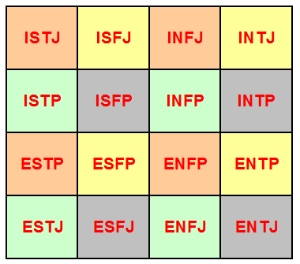Leadership - Myers Briggs Type Indicator
Myers Briggs Type Indicator
Background
It was developed by Isabel Briggs Myers, and her mother, Katharine Briggs in the 1940’s.
It is taken by more than 2 million people each year.
The theory of psychological type was introduced in the 1920s by Carl G. Jung.
The Myers-Briggs Type Indicator® (MBTI) personality inventory clarifies this theory.
This clarification makes it a more useful tool in daily life.
The Myers-Briggs Type Indicator® has proven validity and reliability from over 40 years of use.
Many tests looking at personality type may not be valid.
Some of the types are more common than others and a percentage breakdown of the types in the population has been produced.
You are not required to accept your type but to challenge it and decide on another depending on your circumstances at the time of the test and other factors.
What might appear to be random behaviour are just differences in the use of perception and judgement.
So, in fact, these behaviours have a degree of consistency to them.
We have looked at perception before as part of the definitions of intelligence [see Insight].
People may approach perception in differing ways depending upon underlying values, experiences etc.
The results of this personality assessment is now easily available to individuals or groups.
The process looks at your preferences in responding in 4 areas.
Favourite world
Do you prefer to focus on the outer world or on your own inner world?
This referred to as Extraversion (E) or Introversion (I).
Information
Do you prefer to focus on the basic information you take in or do you prefer to interpret and add meaning?
This is referred to as Sensing (S) or Intuition (I).
Decisions
When making decisions, do you prefer to first look at logic and consistency or first look at the people and special circumstances?
This is referred to as Thinking (T) or Feeling (F).
Structure
In dealing with the outside world, do you prefer to get things decided or do you prefer to stay open to new information and options?
This is referred to as Judging (J) or Perceiving (P).
Some people have a natural ability to influence people and have an intuitive ability with less need to understand the items like ‘type indicators’ in greater detail.
The questionnaire
There is a multiple choice questionnaire either in paper form or online.
It is not a test, there are no correct answers.
The results
The results come in the form of a confidential report via interactive feedback direct from a trained practitioner (best) or via phone. You will receive a copy of the report (paper or via email).
Once you have decided your preferences in these areas you will end up with one of 16 personality types.
These are coded based upon the preferences above and can be represented in a ‘type table’.
Remember that all personality types are equal. There are no good or bad personalities just different ones.
It is the understanding of your own type and how you relate to others that is a key to good leadership.
The final report is based upon a lot more than simple preferences.
Other factors are reported upon, for example.
Dominant function
This preference has the most influence on you.
Auxiliary function
The next strongest preference. It supports and balances the dominant.
Tertiary function
The third strongest preference.
Fourth function
This is the least strongest preference. Often called the inferior function.
A person usually shows one of the preferences to the world.
There is also ‘type development’ where, during you lifetime, different preferences might show up and be used more often and possibly more easily.
In simple form the ‘type indicator’ distinguishes between 8 key areas grouped in 4 pairs.
These represent the letters in the 4x4 grid in the diagram above.
- Introvert (I) of extrovert (E)
- Sensing (S) or intuitive (I)
- Thinking (T) or feeling (F)
- Judging (J) or perceiving (P)
The result of your Myers-Briggs Type Indicator® questionnaire will be a 4 letter label as shown in the grid.
Each combination represents particular behavioural traits.
Each of these has its own good points and negative aspects, for example.
Thinking
Logical, rational and intellectual are positive traits but you may appear to be cold and heartless.
Judging
High work ethic, very reliable and focussed on the job in hand but may be compulsively neat and tidy, too rigid and focussed on rules.


